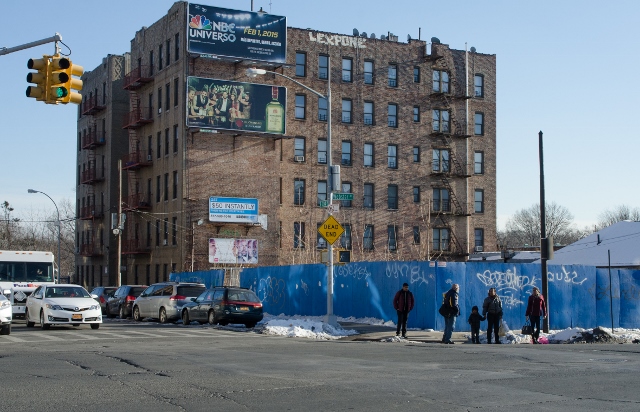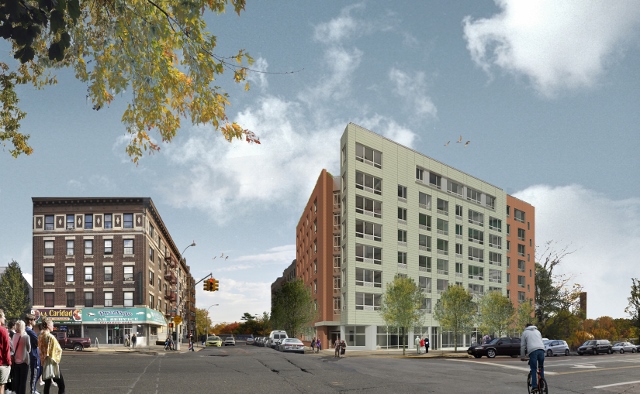
Photo by Jenny Sharp
By DAVID CRUZ
The corner of East 204th Street and Webster Avenue serves as a kind of marquee gateway into Norwood and Bedford Park’s small business community.
Along Webster Avenue, the once barren spur is waking up to a construction boom unseen in recent years, powered by major rezoning in 2009 that encouraged residential and commercial property to some 80 blocks along the strip. North of East 204th is a bustling community of clothing shops and eateries, with merchants clinging a bit longer to reap the benefits of the rezoning and its new neighbors.
It’s a critical crossroad for the neighborhood, a reason why many stakeholders are wondering why The Doe Fund will build a $29.5 million supportive/affordable housing project across from the retail strip, adding to a growing list of neighborhood housing projects designed for a special population. The Doe Fund, a non-profit that primarily assists the formerly homeless, will house HIV/AIDS sufferers along with the working poor.
For many community activists, the supportive housing trend has become the norm, continuing a kind of tug of war between them and arriving developers.
What particularly troubles Barbara Stronczer, doubling as president of the Bedford Mosholu Community Association as member of Community Board 7, was not so much the proposal, but its location. “The site is an anchor for the 204th Street merchant strip,” said Stronczer. “I feel that The Doe Fund should have chosen a better site.”
Some would say Stronczer is the neighborhood historian and diplomatic watchdog. She was there when the Fund, known as a reputable provider, pushed for a similar project in 2007. That project never happened, with the Fund later selling its original space on East Gun Hill Road and Webster Avenue to Concerned for Independent Living, now building a supportive housing site there, said Stronczer.
This time, The Doe Fund purchased the property of 3100 Webster Ave. to build Webster Green–a $29.5 million, eight-story supportive/affordable home. Governor Andrew Cuomo, a proponent of supportive housing, recently gave The Doe Fund $6.5 million for the project.

Photo courtesy The Doe Fund
Webster Green will house 41 supportive and 41 affordable units. An on-site super will occupy a first floor, two-bedroom apartment while 36 studios, 15 one-bedrooms and 30 two-bedroom apartments will be available, said Alexander Horwitz, a spokesman for The Doe Fund. In-house services for The Doe Fund’s clients were unavailable.
But unlike most of the new properties on Webster Avenue, The Doe Fund is exempt from building a storefront, a caveat to the 2009 rezoning. “Setting aside large portions of the footprint for commercial or retail space would reduce space available for the affordable/supportive units,” said Horwitz. “And the need is great.”
This hasn’t sat well with Marcia Cameron, deputy director of the Mosholu Preservation Corporation, who sees supportive housing as working against the overarching Webster Avenue Vision Plan developed by the Four Bronx Institution Alliance comprised of Montefiore Medical Center, Fordham University, The New York Botanical Garden and Bronx Zoo. “If Webster Avenue has a large percentage of supportive housing, this will result in a proliferation of 99 cent stores, thus creating a poor retail mix,” said Cameron in an email, adding that another retail establishment can complement the corner.
One new property that aligns with the vision plan is The Bedford Manor, built by The Stagg Group. Former Bronx Borough President Adolfo Carrion, serving as the firm’s executive vice president, noted that a well-run building is what counts. “If you run a good building whether it’s high income, middle income or low income people, it’s good for the neighborhood,” said Carrion.
In many instances, CB7 has remained a staunch opponent of oversaturated supportive housing. Like many previous plans, The Doe Fund project flies above CB7, an advisory board powerless to halt any project it deems unworthy.
“Community Board 7 has been generous and is willing to do their fair share to shelter people with mental health issues,” said Councilman Andrew Cohen, whose district covers Norwood. “But new housing on Webster must also enhance the community and strike the right balance between the need of the city to house people with special needs and supporting the community’s desire for amenities consistent with a high quality of life in the neighborhood.”
But George T. McDonald, The Doe Fund’s founder and president, dismissed fears the clientele will drag the neighborhood and property values down. “[P]roperty values for homeowners are likely to increase more after a supportive housing development is built, which means a development like this has value for the Norwood community as a whole, not just for those who need this type of housing,” said McDonald in a statement.
At the building abutting the lot at 3100 Webster, tenants sided with The Doe Fund, shrugging off concerns for its supportive housing population. Around the corner, Delfina Sinto, a mother babysitting several of her neighbors’ children, said housing options are scant. “They have the right to live there because there are many people living in the parks,” said Sinto, pointing to nearby Allerton Ballfields.
Another neighbor, Yanirssa Perez, 25, agreed that folks such as the formerly homeless are entitled to live their lives. “Everyone needs a home,” said Perez, who moved into the neighborhood seven months ago from Williamsbridge, Brooklyn. “If they’re supervised, it would be okay.”
Construction is expected to begin sometime this summer with a fall 2017 opening.





This comment removed following mutual agreement.
Can someone tell me were can I get a application, I’m a disabled man that is ill living in a tiny furnish room. And have to walk more then 20 steps to get to the room, is gotten so hard to walk up them stairs can some help me please.
A application for the Webster garden 3100 Webster ave bronx NY thanks. Ben R